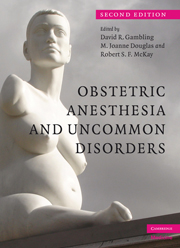Book contents
- Frontmatter
- Contents
- List of plates
- List of contributors
- Preface
- Section 1 Cardiovascular and respiratory disorders
- Section 2 Musculoskeletal disorders
- Section 3 Nervous system disorders
- Section 4 Metabolic disorders
- Section 5 Other disorders
- 17 Blood disorders
- 18 Infectious diseases in pregnancy
- 19 Dermatoses
- 20 Psychiatric disorders in pregnancy
- 21 Malignancy and pregnancy
- 22 Pregnancy and transplantation
- 23 Autoimmune diseases
- Index
- Plate Section
- References
20 - Psychiatric disorders in pregnancy
from Section 5 - Other disorders
Published online by Cambridge University Press: 19 October 2009
- Frontmatter
- Contents
- List of plates
- List of contributors
- Preface
- Section 1 Cardiovascular and respiratory disorders
- Section 2 Musculoskeletal disorders
- Section 3 Nervous system disorders
- Section 4 Metabolic disorders
- Section 5 Other disorders
- 17 Blood disorders
- 18 Infectious diseases in pregnancy
- 19 Dermatoses
- 20 Psychiatric disorders in pregnancy
- 21 Malignancy and pregnancy
- 22 Pregnancy and transplantation
- 23 Autoimmune diseases
- Index
- Plate Section
- References
Summary
Introduction
The peak incidence of affective disorders in women occurs at 23 to 44 years of age, which coincides with the prime child bearing years. Pregnancy and childbirth represent major life stresses, as well as a time of fundamental psychological and social change. The experience of childbirth constitutes a major mental health hazard for women, with an estimated fivefold increase in the appearance of mental illness in the year following childbirth. Women who are pregnant, or have recently given birth, may experience relapses of earlier mental disease or develop a new disorder. Women with psychiatric disorders become pregnant and their psychiatric condition can present management problems at different stages of pregnancy. Less commonly, previously well women may develop a major psychiatric disturbance during or after pregnancy, which may or may not herald a chronic condition. Many of these individuals take medications that have the potential to interact with anesthetic agents and other drugs. These women require considerable tact and skill on the part of their attendants.
The first three years of a consultation-liaison psychiatry service to an obstetric inpatient unit in an Australian hospital had a referral rate of 1.2% of obstetric admissions, totalling 90 consultations over three years. The commonest DSM-III-R psychiatric diagnoses were personality disorders (19%), mood disorders (17%), schizophrenic disorders (15%), and adjustment disorders. Reasons for referral included coping problems, depression, anxiety or fear, and a history of major psychiatric illness.
Obstetric anesthesiologists may have their management skills tested with women who have personality disorders.
- Type
- Chapter
- Information
- Obstetric Anesthesia and Uncommon Disorders , pp. 363 - 370Publisher: Cambridge University PressPrint publication year: 2008
References
- 1
- Cited by

